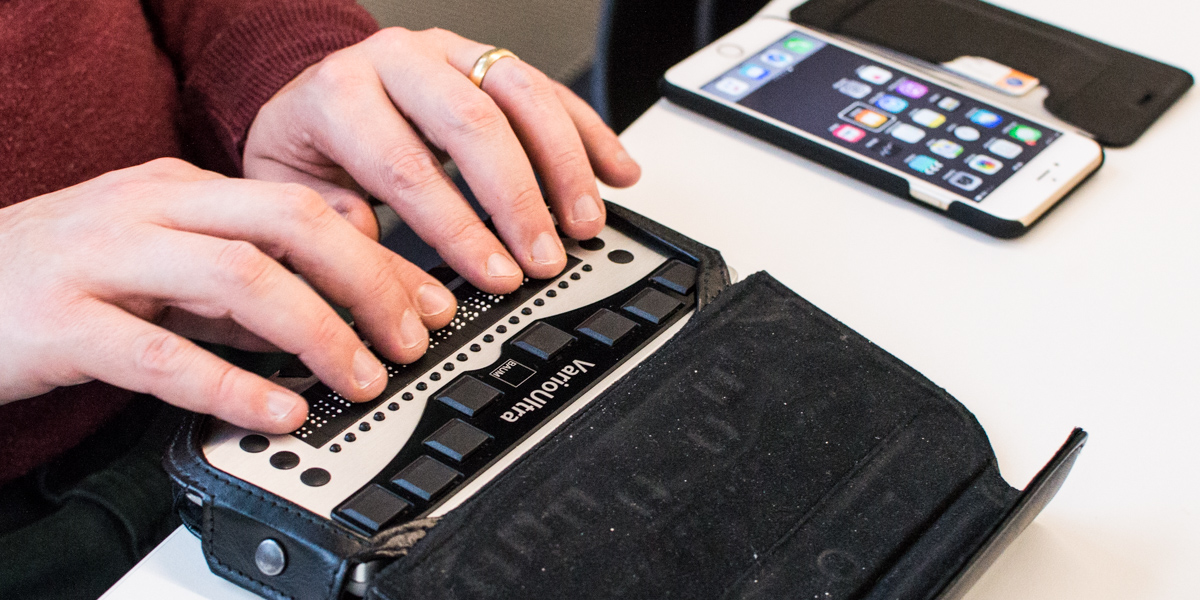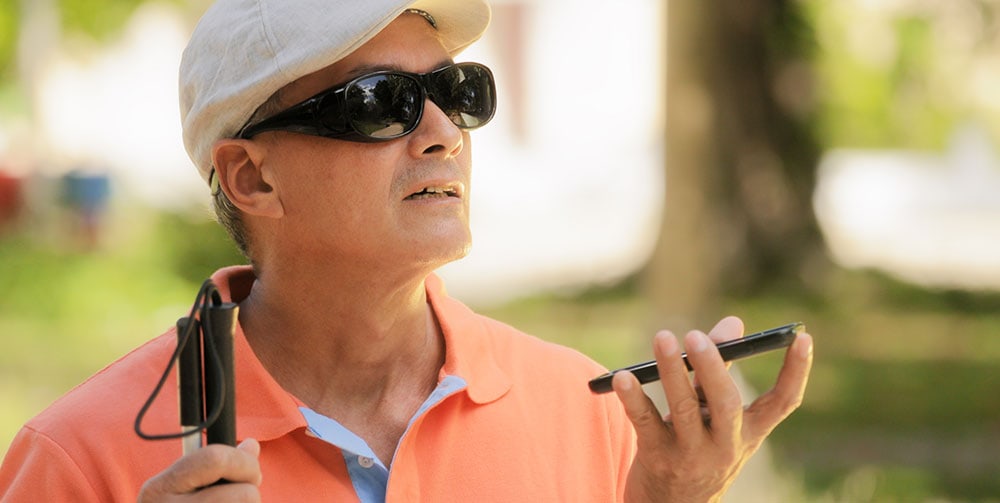Speech-to-Text Devices for Low Vision: Enhancing Ease of Use
A Guide to Life-altering Assistive Innovation for the Blind and Visually Impaired
The advancement of assistive modern technology has introduced a transformative age for individuals who are visually damaged or blind, offering devices that improve freedom and improve everyday experiences. Innovations such as smart navigating devices and AI-driven applications are redefining how customers interact with their environments, while available analysis options and wise home technologies assure to further elevate the top quality of life. As these technologies proceed to evolve, one have to take into consideration not just their functionalities but additionally their influence on fostering self-reliance and inclusivity. What does this mean for the future of availability?
Smart Navigating Tools
Smart navigating devices are changing the means people who are blind or aesthetically impaired communicate with their environment. These advanced modern technologies, which integrate GPS, audio feedback, and haptic signals, supply individuals with essential details regarding their surroundings, boosting their self-reliance and wheelchair.
One prominent example is using wise canes equipped with sensors that spot challenges and give real-time responses via vibrations or audio cues. These devices permit users to browse complicated settings, such as hectic streets or crowded public areas, with increased self-confidence. In addition, wearable gadgets, such as clever glasses, are being developed to help in acknowledging faces, reviewing text, and recognizing items, further augmenting the customer's spatial awareness.
Additionally, smart navigation tools are significantly integrating expert system to analyze data and adapt to customers' preferences. This customized strategy not just enhances navigation performance yet additionally cultivates a sense of empowerment among users. As modern technology remains to advancement, the possibility for smart navigation devices to produce a more inclusive and accessible world for people that are blind or aesthetically impaired stays encouraging, inevitably improving their everyday experiences and communications.
Ingenious Mobile Apps
Mobile applications are becoming powerful tools for assisting individuals who are blind or visually impaired, offering a series of functionalities that enhance daily living. These apps harness progressed modern technology to assist in daily jobs, enhance availability, and advertise self-reliance.
One category of ingenious mobile apps concentrates on aesthetic recognition. Applications like Be My Eyes connect individuals with sighted volunteers via video calls, enabling real-time help for tasks such as checking out labels or navigating unknown settings. Similarly, apps like Seeing AI utilize fabricated knowledge to define surroundings, read text, and identify things, supplying individuals with essential details at their fingertips.
An additional considerable area is navigation and positioning. Apps such as Aira and Neighboring Explorer provide audio guidance, helping individuals navigate urban rooms effortlessly. They offer personalized assistance, permitting a much more positive expedition of the atmosphere.
Furthermore, wellness and health apps cater to certain requirements, such as drug management and health and fitness tracking. These applications aim to cultivate an all natural approach to well-being, making sure that users can maintain their health and wellness separately.
Wearable Assistive Instruments
Wearable assistive gadgets stand for a significant development in modern technology designed to sustain people who are blind or aesthetically impaired. These tools enhance flexibility and self-reliance by supplying real-time feedback concerning the surrounding atmosphere. Amongst the most remarkable wearable innovations are clever glasses furnished with electronic cameras and sensing units, which can identify barriers and relay critical info through audio cues.

Another cutting-edge choice consists of wrist-worn devices that utilize ultrasonic waves to detect challenges and offer navigational assistance. These devices often feature adjustable settings, allowing users to customize the signals to their details demands.
The integration of artificial knowledge in wearable assistive technology is likewise noteworthy, as it continually improves the precision and responsiveness of these gadgets. In general, wearable assistive devices are transforming the lives of the blind and visually impaired, cultivating better autonomy and enhancing top quality of life via innovative solutions.
Accessible Checking Out Solutions
Accessible tortoise eyeglasses analysis services play cheap blue light glasses a vital role in enabling people who are blind or aesthetically impaired to engage with message across various layouts. These solutions include a variety of technologies and devices created to boost analysis experiences, from typical print products to digital content.
One prominent service is Optical Character Recognition (OCR) technology, which transforms printed message into electronic style, permitting customers to pay attention to or check out the material making use of screen viewers. Furthermore, specialized e-readers furnished with text-to-speech capacities use customizable analysis experiences, enabling individuals to readjust font sizes and history shades for improved presence.
An additional effective technique is braille display screens, which supply responsive comments by converting electronic message right into braille. This enables individuals to check out touch, promoting greater self-reliance and accessibility to literature. Additionally, mobile applications designed for reading scanned publications or files can encourage users with instant accessibility to a vast collection of materials.

Smart Home Technologies
Smart home modern technologies have transformed the way individuals who are blind or aesthetically damaged communicate with their living atmospheres, improving both self-reliance and safety. These innovative solutions utilize automation and connectivity to create an obtainable space customized to the requirements of individuals.
Smart audio speakers and voice-activated aides give hands-free control over different tools, enabling users to readjust temperature, lighting, and security steps through simple voice commands. This performance decreases dependence on sighted support and cultivates a feeling of freedom. Furthermore, wise illumination systems can be customized to deliver auditory responses or tactile hints, allowing people to browse their homes a lot more properly.
Furthermore, security systems equipped with smart cameras and sensing units can send out real-time signals to users, enhancing personal safety Resources and security without requiring aesthetic verification. Automated door locks supply comfort, allowing customers to protect their homes easily.
Integrating clever home innovations not only improves everyday living but likewise motivates social communication via connected tools - Assistive technology for the blind. With ongoing innovations in assistive modern technology, the future appears promising, as more solutions will emerge to more empower people that are blind or aesthetically damaged, ensuring an extra comprehensive and independent way of life
Verdict
To conclude, the innovations in assistive modern technology for the aesthetically impaired and blind stand for a significant leap toward improving freedom and top quality of life. Smart navigating tools, cutting-edge mobile applications, wearable tools, obtainable analysis solutions, and clever home modern technologies collectively promote a comprehensive setting. This assimilation of technology not just boosts wheelchair and everyday living yet additionally empowers individuals to engage fully with their surroundings, advertising better autonomy and involvement in society.
Developments such as wise navigation tools and AI-driven applications are redefining just how customers interact with their environments, while accessible reading services and clever home innovations promise to more elevate the quality of life. As technology continues to breakthrough, the capacity for wise navigating devices to create a more easily accessible and comprehensive globe for people who are blind or visually impaired continues to be appealing, eventually reshaping their day-to-day experiences and interactions.
Wearable assistive gadgets stand for a substantial innovation in technology created to sustain people that are blind or visually impaired. Amongst the most notable wearable modern technologies are wise glasses geared up with electronic cameras and sensing units, which can determine barriers and relay crucial details with audio signs.
Smart navigating tools, cutting-edge mobile applications, wearable devices, available reading services, and smart home technologies collectively promote a comprehensive setting.